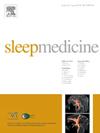在一个极早产儿样本中,睡眠结构与神经和神经行为的短期和中期结果相关。一项初步研究
IF 3.8
2区 医学
Q1 CLINICAL NEUROLOGY
引用次数: 0
摘要
新生儿大部分时间都在睡觉。这种活动促进神经发育。早产的定义是在妊娠37周之前出生,它破坏了正常的子宫内大脑编程,其长期后果会带来沉重的社会负担。睡眠改变可能会导致这些后遗症。在这项初步研究中,我们旨在描述极早产儿(VPI)的24小时睡眠状态分布,并将其与矫正年龄(CA) 6个月前的神经行为评估相关联。其次,我们的目的是评估MRI检测到的脑损伤是否会影响睡眠时间、结构和质量。在经后32周(PMA)用24小时视频多导睡眠图对10例VPI进行评估,并在记录时、足期等效年龄(TEA)和6个月(CA)时接受神经行为检查。分析睡眠阶段分布和转换,并进行功率谱分析。在PMA 32周、TEA和CA 6个月时,总睡眠时间和安静睡眠量与神经学和神经行为评估呈正相关,而睡眠开始活跃睡眠(SOAS)呈负相关。患有脑病变的婴儿,其QS时间较短,同时伴有较高的AS + SOAS患病率,并且在SOAS期间左半球后脑区表现出较高的后脑慢活动强度(慢δ和δ)梯度。了解早产儿的睡眠动态可能会提供未来的治疗/管理策略,这需要包括睡眠护理。本文章由计算机程序翻译,如有差异,请以英文原文为准。

Sleep architecture correlates with neurological and neurobehavioral short- and mid-term outcome in a sample of very preterm infants. A pilot study
Newborns spend most of their time sleeping. This activity fosters neurodevelopment. Prematurity, defined by birth occurring prior the 37th week of gestation, disrupts normal brain in-utero programming, with long-lasting consequences that carry a high social burden. Sleep alterations may contribute to these sequelae. In this pilot study we aimed to describe the 24-h distribution of sleep states among very preterm infants (VPI), and to correlate it with neurobehavioral assessment up to 6 months of corrected age (CA). Secondly, we aimed to assess if the presence of a brain lesion detected at MRI could affect sleep duration, architecture, and quality.
Ten VPI were assessed at 32 weeks postmenstrual age (PMA) with a 24-h video-polysomnography and received a neurobehavioral examination at the time of the recording, at term equivalent age (TEA), and at 6 months CA. Analysis of sleep stages distribution and transitions, and power spectra were conducted.
Total sleep time and amount of quiet sleep positively correlated with neurological, and neurobehavioral assessment at 32 weeks PMA, at TEA, and at 6 months CA, while Sleep Onset Active Sleep (SOAS) had a negative association. Infants carrying brain lesions showed lower QS time accompanied by a higher prevalence of AS + SOAS and showed a gradient for higher power of posterior slow activity (slow δ and δ) during SOAS in the left hemisphere posterior regions.
Understanding sleep dynamics among preterm infants might provide future therapeutic/management strategies, which need to encompass sleep care.
求助全文
通过发布文献求助,成功后即可免费获取论文全文。
去求助
来源期刊

Sleep medicine
医学-临床神经学
CiteScore
8.40
自引率
6.20%
发文量
1060
审稿时长
49 days
期刊介绍:
Sleep Medicine aims to be a journal no one involved in clinical sleep medicine can do without.
A journal primarily focussing on the human aspects of sleep, integrating the various disciplines that are involved in sleep medicine: neurology, clinical neurophysiology, internal medicine (particularly pulmonology and cardiology), psychology, psychiatry, sleep technology, pediatrics, neurosurgery, otorhinolaryngology, and dentistry.
The journal publishes the following types of articles: Reviews (also intended as a way to bridge the gap between basic sleep research and clinical relevance); Original Research Articles; Full-length articles; Brief communications; Controversies; Case reports; Letters to the Editor; Journal search and commentaries; Book reviews; Meeting announcements; Listing of relevant organisations plus web sites.
 求助内容:
求助内容: 应助结果提醒方式:
应助结果提醒方式:


